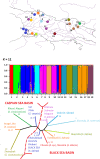Genetic structure of Ponto-Caspian trout populations shows gene flow among river drainages and supports resident Salmo rizeensis as a genetically distinct taxon
- PMID: 37496759
- PMCID: PMC10365970
- DOI: 10.1002/ece3.10335
Genetic structure of Ponto-Caspian trout populations shows gene flow among river drainages and supports resident Salmo rizeensis as a genetically distinct taxon
Abstract
To assess the genetic structure of Ponto-Caspian brown trout (Salmo trutta complex) populations, we analyzed both mitochondrial DNA sequences and genotypes at 10 microsatellite loci of fish caught in the Black Sea and from nine river catchments in Georgia, flowing into either the Black or Caspian seas. The results show that: (1) there is substantial genetic differentiation among Ponto-Caspian trout populations, both among the populations of different nominal species and within those of the same species; (2) the genetic distance between conspecific populations from the Black and Caspian Sea basins exceeds that among the populations within the same basin. Moreover, within drainages, genetic distance correlates with the geographic distance; (3) the Black Sea itself is not a barrier to gene flow among the watersheds draining into the Black Sea; (4) some populations in the headwaters of the rivers draining into the Black Sea Basin fall out of this pattern and likely form a separate, non-anadromous (resident) taxon, previously described from northeastern Turkey as Salmo rizeensis. This hypothesis is supported by mitochondrial DNA phylogeny. The presence of both anadromous and resident populations in a single river basin calls for a substantial re-thinking of speciation patterns and taxonomy of Eurasian brown trout.
Keywords: Ponto‐Caspian region; Salmo caspius; Salmo labrax; Salmo rizeensis; anadromy; brown trout; isolation by distance; resident forms.
© 2023 The Authors. Ecology and Evolution published by John Wiley & Sons Ltd.
Conflict of interest statement
None declared.
Figures







References
-
- Arkhipkin, V. S. , Kosarev, A. N. , Gippius, F. N. , & Migali, D. I. (2013). Seasonal variations of climatic fields of temperature, salinity and water circulation in the Black and Caspian seas. Вестник Московского университета [Vestnik Moskovskogo Universiteta], 44, 33–43.
-
- Arostegui, M. C. , Quinn, T. P. , Seeb, L. W. , Seeb, J. E. , & McKinney, G. J. (2019). Retention of a chromosomal inversion from an anadromous ancestor provides the genetic basis for alternative freshwater ecotypes in rainbow trout. Molecular Ecology, 28(6), 1412–1427. - PubMed
-
- Bandelt, H. J. , Forster, P. , & Röhl, A. (1999). Median‐joining networks for inferring intraspecific phylogenies. Molecular Biology and Evolution, 16(1), 37–48. - PubMed
-
- Barach, G. P. (1962). Chernomorskaya kumzha (losos' forel') [The Black Sea trout (salmon–trout)]. Izd. Akad. Nauk GruzSSR.
Associated data
LinkOut - more resources
Full Text Sources

